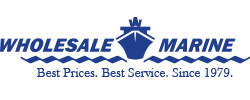Choosing the right boat steering system can dramatically improve handling, safety, and comfort. Two of the most common types are hydraulic steering and mechanical (cable) steering, each offering unique benefits depending on your boat's size, horsepower, and performance goals.
This guide breaks down how each system works, compares their pros and cons, and helps you decide which one is right for your setup.
When you're ready to upgrade or replace your steering components, explore Hydraulic Steering Kits and Accessories at Wholesale Marine.
How Mechanical Steering Works
Mechanical (cable) steering is one of the most widely used systems in small to mid-sized boats. It uses a push-pull cable that connects the steering wheel (helm) to the outboard motor or rudder. Turning the wheel pushes or pulls the cable, rotating the motor an changing direction.
Best for:
- Boats under 150 HP
- Single-engine setups
- Freshwater or smaller recreational boats
Advantages:
- Simple and affordable
- Easy to install and maintain
- Minimal parts - fewer points of failure
Drawbacks:
- Steering effort increases with engine torque
- Cable friction can cause stiffness over time
- Not suitable for large or dual-engine boats
If your cable system is starting to feel sluggish or tight, our Upgrading from Mechanical to Hydraulic Steering Guide walks through everything you need for a smooth conversion.
How Hydraulic Steering Works
Hydraulic steering systems use fluid pressure to transmit steering input from the wheel to the outboard motor or rudder. When the wheel turnsm a helm pump pushes fluid through hoses to a hydraulic cylinder, which moves the motor smoothly and precisely.
Best for:
- Boats over 150 HP or multi-engine configurations
- Offshore, high-performance, or saltwater boats
- Pontoons and larger vessels requiring precise control
Advantages:
- Smooth, effortless steering - even under load
- Handles high torque from larger engines
- Excellent for long-distance or heavy-duty boating
Drawbacks:
- Higher upfront cost
- Requires occasional fluid checks and bleeding
- Slightly more complex installation
Hydraulic systems provide superior hanbdling in challenging conditions. Learn more about how these systems perform across different boat types in our Choosing the Best Steering System for Your Boat Type post
Side-by-Side Comparison: Hydraulic vs. Mechanical Steering
|
Feature |
Cable Steering |
Hydraulic Steering |
|
Ease of Use |
Moderate, more effort on big boats |
Effortless, smooth control |
|
Maintenance |
Lubricate cables, inspect tension |
Check fluid, inspect hoses & seals |
|
Cost |
Low |
Moderate to high |
|
Ideal Boat Size |
Small to medium boats under 150HP |
Medium to large (150+ HP) |
|
Precision |
Moderate |
High |
|
Lifespan |
Long with Proper maintenance |
Long with proper maintenance |
Which Steering System is Right for You?
The best choice depends on your boat size, engine power, and performance expectations:
- For small recreational boats: Mechanical steering is affordable and easy to maintain.
- For larger or dual-engine vessels: Hydraulic steering offers smoother, more reliable control.
- For performance or offshore setups: Hydraulic systems deliver superior precision and safety.
If you're steering feels stiff, or you're moving to a higher horsepower engine, upgrading is a smart investment. Check out our Boat Steering & Control Systems Guide to understand how your helm, throttle, and steering components all work together for safe operation.
Maintenance and Longevity Tips
Both systems benefit from regular inspection and upkeep:
Mechanical Steering:
- Lubricate cables annually
- Inspect for corrosion and kinks
- Replace worn or frayed cables immediately
Hydraulic Steering:
- Check fluid levels monthly
- Inspect hoses and fittings for leaks
- Bleed air from the system annually
For an easy checklist and troubleshooting tips, visit Troubleshooting Common Boat Steering Issues.
Frequently Asked Questions About Hydraulic vs. Cable Steering
What’s the main difference between hydraulic and mechanical steering?
Hydraulic steering uses fluid to transmit motion, offering smoother control, while mechanical steering uses cables for a more direct—but heavier—feel.
When should I upgrade from mechanical to hydraulic?
If your boat exceeds 150 HP, has dual engines, or requires tighter control, hydraulic steering is the better choice.
Is hydraulic steering harder to maintain?
Not at all — it just requires fluid checks and occasional bleeding to keep performance smooth.
Which system lasts longer?
With proper maintenance, hydraulic steering typically outlasts mechanical systems due to reduced friction and wear.
Ready to Find Your Perfect Steering Setup?
Whether you choose mechanical simplicity or hydraulic precision, the right system ensures smoother handling and safer boating.
Shop Boat Steering Systems & Accessories at Whoelsale Marine to find everything from helm pumps and hydraulic hoses to complete conversion kits.
